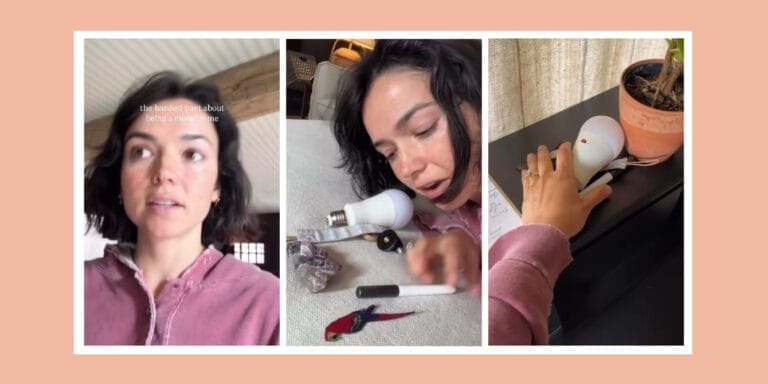What is vaginal seeding? First-of-its-kind study explains benefits for C-section babies

maxim ibragimov/Shutterstock
Research is still emerging, but vaginal seeding may soon become a more widely used practice after C-section deliveries.
We independently select and share the products we love—and may receive a commission if you choose to buy.
Table of Contents
Despite what you might think, we’re not born with an already-flourishing gut microbiome—that’s another gift passed down to us from our mothers during birth. But for babies delivered via C-section—31.8% of all U.S. births in 2020—that’s not always the case. Because microbiome “seeding” happens during a baby’s descent through the birth canal, if that’s bypassed, an infant will miss out on the potential to be colonized with the mother’s bacteria, which in turn may delay the development of their microbiome, and could lead to a higher risk of chronic disease down the line.
Now, in a first-of-its-kind, double-blind, randomized, placebo-controlled clinical trial, researchers have shown that a technique known as vaginal seeding at birth can effectively provide newborns with beneficial bacteria—even if they weren’t delivered through the birth canal.
Research is still emerging, but vaginal seeding after C-section may soon become a more widely used practice. Here’s what to know—and if you’re pregnant, what to ask your birth provider.
What is vaginal seeding?
Vaginal seeding is the process of swabbing a newborn infant’s face at birth with a piece of gauze that has been saturated with the mother’s vaginal fluids, in an effort to “seed” the infant’s microbiome with beneficial bacteria.
According to OB-GYN Aviva Romm, MD, the procedure is quite simple: “A sterile gauze is folded into a ‘fan’ shape. This is then moistened with sterile water and inserted into the vagina and left to ‘colonize’ for one hour. The gauze is then removed and put into a sealed bag until the birth of the baby. At birth, the swab is wiped over the baby’s face to mimic passage through the birth canal,” she writes in a blog post. The seeding is usually done immediately after delivery and before starting skin-to-skin contact with the mother.
A clinical study published in the journal “mBio” found that the technique is effective. In a study of 20 infants born by elective C-section before their mothers went into labor, researchers discovered that the babies who underwent vaginal seeding had new strains of maternal bacteria present in their bodies.
“These strains normally wouldn’t be present in the newborns because, during C-sections, infants are directly extracted from their mothers’ wombs, bypassing the vaginal canal,” the study authors wrote. The researchers are continuing to follow the babies until age 3 to continue assessing the impact on their microbiome.
“Despite some limitations in this early study, including a small sample size and only two samples taken over time, we observed significant effects of vaginal seeding on the neonatal microbiota,” said Maria Gloria Dominguez-Bello, an author of the study and the Henry Rutgers Professor of Microbiome and Health at the Department of Biochemistry and Microbiology in the Rutgers School of Environmental and Biological Sciences (SEBS), in a press release. Dominguez-Bello is a leading researcher in the study of the infant microbiome.
The microbiome connection
During a vaginal birth, an infant is exposed to bacteria found in the mother’s vaginal canal and perianal region. The infant’s skin becomes inoculated with this bacteria during delivery, and the infant will simultaneously inhale and ingest the bacteria, seeding their digestive system with “pioneer” organisms. “These organisms then multiply and adapt to their various locations on and in the newborn’s body, partly mimicking the mother’s microbiome, and also forming the foundation of the baby’s own unique microbial signatures,” writes Dr. Romm.
If this process doesn’t occur, such as during a C-section birth, then the microbial colonization may be disrupted, delayed or could develop differently. This altered development is associated with a higher risk of immune and metabolic diseases, such as asthma, autoimmune diseases and food allergies, among other issues, states Marea Goodman, LM, CPM, a midwife and co-author of the book Baby Making for Everybody: Family Building and Fertility for LGBTQ+ and Solo Parents, and who uses vaginal seeding in her midwifery practice.
“I think vaginal seeding has the potential to be hugely beneficial and has very minimal risks. It makes sense logically, as well as from a research standpoint, to introduce babies to healthy vaginal bacteria when they are born,” Goodman tells Motherly.
Risks and considerations with vaginal seeding
Opting for vaginal seeding at birth can be an empowering way to make an informed decision about your birth experience. But there is a small risk for infection associated with the practice, so not everyone is a good candidate for vaginal seeding after C-section.
Your birth provider may not recommend vaginal seeding if you have an active gonorrhea or chlamydia infection, an active herpes infection, group B strep, or an active yeast infection, Goodman says. “Each of these viruses or bacteria could potentially pass to the baby and carry with them a small risk of causing health issues for the infant.”
Check with your OB-GYN or midwife to see if vaginal seeding makes sense for you, or if there are ways to reduce the potential risks of infection.
“It may also be supportive to eat fermented foods, reduce sugar, take apple cider vinegar, and do other measures to support your healthy vaginal flora before birth,” Goodman recommends.
And as an alternative to vaginal seeding, there are several ways to boost your baby’s microbiome after birth, including using infant probiotic supplements and starting breastfeeding and immediate skin-to-skin contact.
A note on vaginal seeding at birth
Though more research is needed, the evidence suggests that vaginal seeding is a beneficial way to support your infant’s microbiome at birth. “There is now a critical need to evaluate the health benefits and safety of vaginal seeding in large randomized controlled trials,” Dominguez-Bello said. If you’re curious about whether it’s an option for you, speak to your birth provider.


































